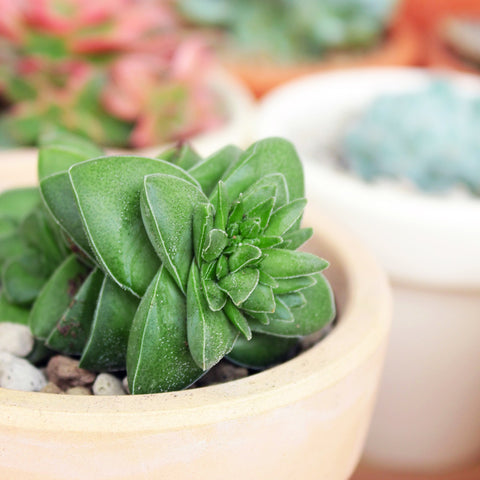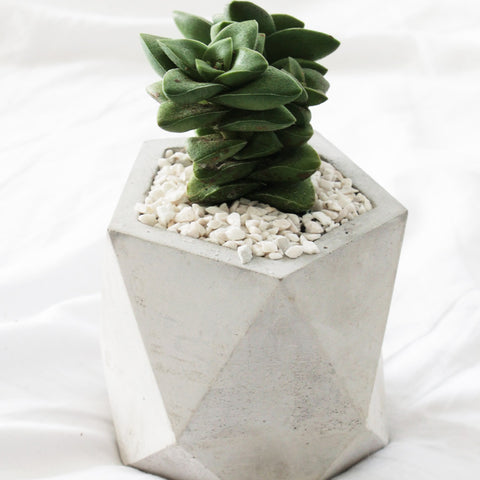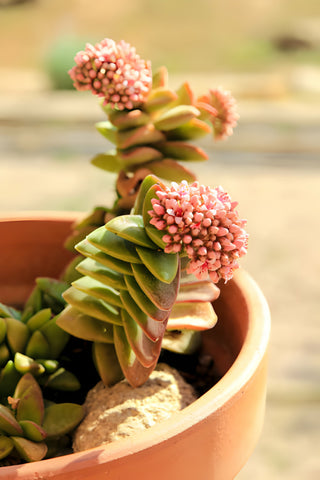Crassula Springtime is a captivating hybrid succulent, originating from the crossbreeding of Crassula perfoliata var. minor and possibly Crassula rupestris. This unique succulent was first introduced in California, United States sometime before the 1980s. Crassula 'Springtime' shares some distinctive characteristics with other members of the Crassula genus. Like many Crassula species, it typically forms a rosette shape with fleshy, succulent leaves. The leaves are often arranged in a compact and overlapping manner, creating an attractive and symmetrical appearance. The plant's ability to store water in its leaves is a common trait among Crassula species, making them well-adapted to arid conditions.
Crassula Springtime has a slow-growing nature, boasting thick green foliage that lends an exquisite touch to its overall appearance. This succulent can climb up to 6 inches in height, making it an ideal choice for ground cover or an attractive addition to hanging baskets. Its grey-green leaves, which are fleshy and densely packed around a delicate stem, create a visually appealing arrangement.
Adding to its allure, Crassula Springtime features a remarkable flowering display during late winter to early spring. This succulent produces dense clusters of pink, star-shaped flowers, each adorned with a striking red hue at its center. With its low-maintenance nature, distinctive foliage, and delightful blossoms, this plant can bring vibrancy and spruce up any living space.
Toxicity
Crassula Springtime is generally considered non-toxic to humans, but it may cause allergic reactions in some individuals. However, please note that this succulent is toxic to cats and other pets. It contains compounds that can cause gastrointestinal distress in animals. Ingesting parts of these succulents may lead to symptoms such as vomiting, diarrhea, and lethargy in feline companions. Pet owners should exercise caution and take preventive measures to keep these plants out of reach of curious pets to avoid potential health issues. If a pet shows signs of discomfort or exhibits unusual behavior after exposure to the plant, contact your veterinary promptly for appropriate care and guidance.
In households with animals, keeping the plant out of reach is advisable to prevent ingestion. Taking precautions is important to ensure the safety of both humans and pets is crucial when introducing plants into a living environment.

Crassula Springtime is attractive due to its unique appearance.
General Care
Lighting
Crassula Springtime succulent thrives in well-lit conditions, preferring bright, indirect sunlight. While it can tolerate some direct sunlight during the morning and late afternoon, excessive exposure to intense rays may lead to leaf burn. For outdoor planting, it's advisable to offer shade during the hottest part of the day. When cultivating indoors, positioning the plant near a south or west-facing window can ensure it receives ample bright light for robust growth. To soften harsh sunlight, a sheer curtain can be used. Take note of the specific lighting conditions in your indoor environment and adjust the positioning accordingly to provide the ideal light exposure for this charming succulent.
It's crucial to be aware that insufficient light may result in your succulent becoming leggy or elongated, making it weak and prone to tipping over. To prevent this, providing adequate light is essential, and supplementing with a grow lamp can encourage healthy growth.
Watering
Crassula Springtime store water in its leaves and stems, so it has low watering requirements. This succulent prefers a moderate watering routine and should not be overwatered, as overwatering poses a significant risk, potentially leading to root rot and other issues. It's essential to allow the top inch of the soil to dry out between watering sessions. During the active growing season in spring and summer, you can increase the frequency of watering, but always ensure that the soil has a chance to dry partially before the next session. As fall and winter approach, the plant enters a dormant period, and you should reduce the watering frequency, allowing the soil to dry out more thoroughly between sessions.

Thick green leaves is where the plant stores water.
When watering your Crassula Springtime, make sure to water the soil and roots directly, avoiding getting water on the leaves to prevent potential issues like rot. It's important to let any extra water drain out completely and remember to empty the saucer underneath the pot. This helps prevent water from collecting in the pot, reducing the risk of root rot. This simple watering practice keeps your plant healthy and happy. When cultivated outdoors, this succulent can often rely on natural rainfall. However, in hot and arid climates or when grown in containers, occasional watering may be necessary to supplement moisture levels.
Soil And Fertilizer
Crassula Springtime thrives in a well-draining soil mix, ideally suited for succulents or cacti. This type of soil promotes proper drainage, preventing waterlogged conditions that can lead to root rot. It is crucial to ensure that the soil allows for adequate aeration, allowing the plant's roots to breathe and facilitating optimal growth.
In terms of fertilization, during the growing season, which typically spans spring and summer, a balanced and diluted succulent fertilizer can be beneficial. However, it's essential to approach fertilization with caution, as succulents generally do not require frequent feeding. Following the instructions provided on the fertilizer package is crucial to avoid over-fertilizing, which can potentially harm the plant. Before applying fertilizer, it is recommended to water the plant adequately. This helps prevent any stress on dry roots and ensures that the nutrients from the fertilizer are more effectively absorbed. It's advisable to monitor the plant's response to fertilization and adjust the frequency and concentration accordingly.
Temperature And Humidity
Crassula Springtime is well-suited to average room temperatures, thriving in a range between 65°F to 75°F. This temperature spectrum is ideal for its growth, ensuring a comfortable environment for the succulent. The plant showcases resilience to moderate temperature fluctuations, adapting well to typical indoor climate conditions. Springtime can withstand temperatures down to 30°F. While it can endure cooler conditions for short periods, it is advisable to protect the plant from prolonged exposure to frost or extremely low temperatures. In regions where frost is a concern, it is recommended to bring the succulent indoors during winter or provide adequate protection to prevent cold-related damage. This approach ensures the plant's continued health and vitality, allowing it to thrive in more favorable conditions once the cold period subsides.
In terms of humidity, Springtime is known for its adaptability to standard indoor humidity levels (30-50%). It can withstand drier conditions, a common trait among succulents. While the plant is relatively robust, maintaining a balanced indoor humidity level is generally beneficial for its overall health. Extreme humidity, especially on the higher end of over 50%, should be avoided, as it might increase the susceptibility to fungal issues.
Repotting
For Crassula Springtime to thrive, it's important to set up the right conditions when planting and handling its soil. First, pick a pot with holes at the bottom to let excess water drain out easily. Use soil that drains well, and if possible, choose a pot made of materials like concrete or ceramic that help air circulate around the roots. It's also helpful to make sure the soil gets enough air. You can do this by gently stirring the soil around the roots every week with a shovel to create spaces for the roots to absorb water, nutrients, and air.
When it comes to repotting, do it carefully, especially if the plant has become too big for its current pot or the soil isn't as nutritious as before. A good rule is to do this every two to three years, preferably in spring or summer when the plant is growing actively. Choose a new pot that's just a bit larger than the current one (about 1 size or 10% larger) to give the plant enough room to keep growing.
Pruning
Pruning Crassula Springtime is a straightforward process that helps maintain its overall shape, encourage bushier growth, and get rid of any damaged or dead parts. Keep a regular eye on the plant for any yellow or shriveled leaves, and remove them from the base to keep the plant looking neat. If the plant starts getting too tall or stretched out, trim the stems just above a leaf node to promote a more compact and full appearance. After the flowering season, trim the flowering stems by cutting them just above a set of healthy leaves. You can also shape the plant by trimming the tips of the stems to control its size or maintain a specific form. Pruning is a task that can be carried out as needed throughout the growing season. Remember to use clean and sharp tools when pruning to avoid causing stress or damage to the plant.
Propagation
Propagating Crassula Springtime can be done through two main methods: stem cuttings and offsets.
When propagating from stem cuttings, begin by selecting a healthy stem from the mature plant. Use clean scissors or pruning shears to make a precise cut, ensuring the tool is sanitized to prevent infections. Allow the cut end of the stem to callus for a day or two, a crucial step in preventing rot, before planting it in a container with well-draining soil. During the initial stages, water the cutting sparingly and place it in an area with bright, indirect light until it establishes roots.
Offsets, sometimes referred to as pups or baby plants, naturally occur at the base of the mature Crassula 'Springtime.' Carefully separate an offset from the main plant, ensuring it retains a small section of the stem. Allow the cut end of the offset to callus for a day or two before planting it in a separate pot with well-draining soil. Lightly water the offset and position it in an area with bright, indirect light to encourage healthy growth.
You can also experiment with propagating this plant with leaf cutting, but the success rate is significantly lower when compared to the 2 above-mentioned methods.
Blooming
Crassula Springtime has a charming and visually appealing blooming period. During late winter to early spring, this succulent produces dense clusters of scented light pink flowers. Each flower can reach up to 2 inches in width, and they exhibit a delightful red hue at the center, adding to the overall allure of the plant. The blooming phase is a delightful feature that enhances the aesthetic appeal of Crassula Springtime, making it an even more enchanting addition to indoor or outdoor spaces.
Encouraging blooming in Crassula Springtime involves providing optimal care and creating conditions conducive to its flowering cycle. Ensure the plant receives bright, indirect sunlight, consistent and moderate watering, and occasional fertilizing during the growing season. You can also mimic seasonal changes by allowing the plant a period of rest during the winter, reducing watering, and keeping it in a slightly cooler environment. Through consistent care, you can enhance the likelihood of Crassula Springtime producing its beautiful blooms.

Crassula Springtime Flowers
Common Problems
Crassula Springtime is generally a hardy succulent, but like any plant, it may encounter certain issues. Overwatering is a common problem, leading to root rot and other related complications. Ensure the soil is well-draining, and allow it to dry out between waterings. Another potential issue is legginess or elongation of stems, indicating insufficient light. Provide adequate bright, indirect sunlight to prevent this. Pests such as mealybugs or aphids may occasionally infest the plant; address them promptly with appropriate pest control methods. Keep an eye out for signs of stress or discoloration, which could be a response to extreme temperatures, inadequate light, or other environmental factors. Adjust care accordingly to address these concerns and promote the overall health of your Crassula.






























